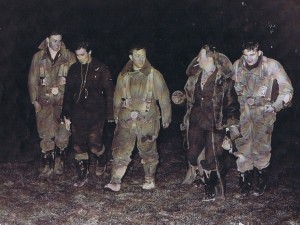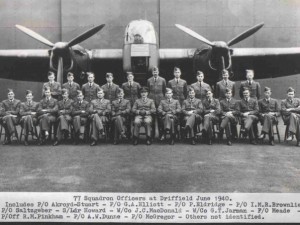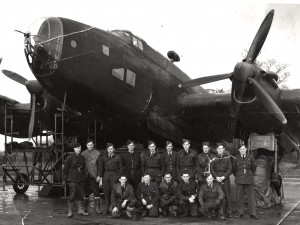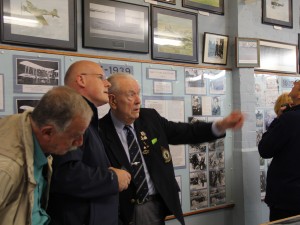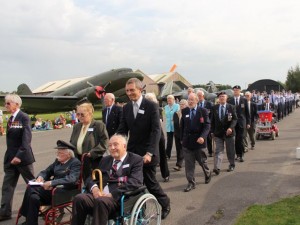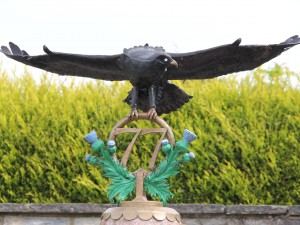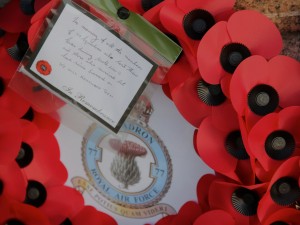About 77 Squadron Association
We exist to keep alive the memory of 77 Squadron Royal Air Force, all who served in it and especially those killed in action.
The Association is open to all with an interest in the squadron; and especially welcome if you are related to someone who served with the squadron in whatever capacity.
The squadron was disbanded in 1963. Like all other WWII organisations, we are increasingly and inevitably losing our veterans. It is all the more important therefore that we pass on their experiences and sacrifices made by their comrades. We are one of the few active wartime squadron associations as we are proud to say that the interest from descendants and from the general public is increasing rather than diminishing as we embrace the digital era.
THE ASSOCIATION: Following the sad passing of our Secretary, Treasurer, Historian, and Editor, Van Wilson, in July 2023, we have re-formed the Committee. Van was known to all who attended the reunions and to many in correspondence. You can read more about her remarkable life here.
Join the Association to support us and receive The Nickel, a twice-yearly magazine packed with continually new information. Details here.
Existing members: To renew your annual subscription from 1st January: £12 for UK . Overseas: £17 to include a printed and mailed magazine or £12 to include an emailed magazine. Pease either pay by cheque to: Hon Treasurer, 77 Squadron Association, 24 Blakeney Place, York YO10 3HZ or direct to the bank account: Account name: 77 Squadron Association; Account Number: 92348036; Sort code: 09 01 28 and inform us by email: info@77squadron.org.uk
We are all volunteers on the committee which now comprises:
Andrew Brown, Chair
Maxine Brown, Membership Secretary
Rachel Semlyen, MBE, Treasurer & Webmaster
Alec Brown, Magazine Editor
Paul Markham, Historian Researcher
We are grateful too to :
Canadian Representative: Bryan Naylor
Canadian Archivist: Michael J. Anglin
Australian Archivist: Lesley Gent
You can contact us by email: info@77squadron.org.uk
Operational Record Books (ORBs) of 77 Squadron from Sep 1939 until Dec 1945. Included in these records are the monthly RAF Form 540 – Summary of Events (a daily diary of events at the Sqn), RAF Form 541 – Detail of Work Carried Out (a record of what aircraft and personnel took part in Operations) as well as various appendices with supplementary information including Ops Orders, bomb camera pictures etc. The ORB copies are of various levels of quality based on the available content from National Archives. Feel free to download and use the information for non-commercial uses as you see fit in order to research family members or those connected to 77 Squadron. Our grateful thanks go to Michael J. Anglin for this tremendous work.
Roll of Honour page has a list of the 101 Canadians killed in action and the 37 Australians, as well as the full, 890 members of the squadon KIA list. We are grateful to members Lesley Gent in Australia and Michael J. Anglin in Canada for their dedicated work in providing a face and a background to these brave young men who left their homelands to fight, and die, for our freedom.
The squadron archives are housed at the Yorkshire Air Museum, Elvington. To access information, contact us, or the museum’s Collection Officer, Sarah Maultby, email: sarah.maultby@yorkshireairmuseum.org
Yorkshire Air Museum & Allied Air Forces Memorial at Elvington, was the squadron’s base from October 1942 to May 1944. We have a memorial at the gate, our Squadron History Room in the Bomber Command Building and the famous full-size Halifax, “Friday the 13th” in the main Canadian Memorial Hangar. The Halifax can be booked for private tours.
The Nickel is our newsletter with news of veterans and events, historical articles, photographs and letters from members. Members can now read this online as well as in print format. We maintain a Facebook page and donations help maintain this website.
We endeavour to answer queries about the members of the squadron from the operational records and from the archives held at the museum, and we are grateful to new committee member, Paul Markham for this exacting and valuale work. Email: info@77squadron.org.uk
WEBSITE NAVIGATION: To read the squadron history, go to the History tab below the flags at the top of any page (not on the picture or on the graphics on this home page). From there you can go to different sections of our history. Enjoy reading!.
77 Squadron, Royal Air Force
A brief history
(A fuller account is on the History pages reached from the History tab under the flags at the top of the page).
Formed 100 years ago, initially for the defence of Edinburgh in 1916, apart from a period on anti-submarine duties with Coastal Command in North Devon in 1941, the squadron was based in the countryside of North Yorkshire from 1938 to May 1945 as part of Bomber Command. Flying Armstrong Whitworth Whitleys, the squadron carried out the most sorties: 1,909, and lost the most aircraft: 107, with 285 casualties…more than any other squadron. This included a fateful night at Driffield when, with 102 Squadron, 12 aircraft were destroyed and 11 ground staff lost their lives in a Luftwaffe bombing raid. But its worst period was still to come.
In October 1942 the squadron was the first occupant of the newly-built RAF Elvington airbase. Here the crews had to re-train on the Handley Page Halifax. 14 airmen lost their lives in accidents before the squadron resumed operations in February 1943. During the following 18 months they carried out 3,692 sorties, lost 82 aircraft and a further 450 aircrew—more than half the squadron’s total fatalities in the whole war.
77 Squadron consisted of both regulars and volunteers who were supported by hundreds of ground crew and technical staff, both men and women. Amongst the aircrew were young men from Australia, Canada, New Zealand, South Africa and the USA. Operations included leaflet drops (code-named Nickels), mine-laying and petrol runs, as well as bombing raids. 77 handed Elvington over to the French squadrons in May 1944 and moved to Full Sutton.
In 1945 it transferred to Transport Command with Dakotas and hence to Mauripur, India, dropping supplies and bringing home prisoners of war from the Far East.
It took part in the Berlin Airlift in 1948 / 49 ferrying fuel to the citizens of Berlin stranded as a result of the Cold War blockade.
The squadron disbanded in 1963. Although there had been informal get-togethers of veterans previously, this Association was formally founded in 1988.
Approximately 1,800 aircrew served with the squadron in the 2nd World War
890 were killed in action and 4 died as prisoners of war
216 were captured, 20 successfully evaded
104 are buried in the UK and Ireland, 322 in Germany and the remainder in Belgium, Denmark, Holland, France and Poland
230 have no known grave and are commemorated at Runnymede
to Bomber Command
“All your operations were planned with great care and skill.
They were executed in the face of desperate opposition and appalling hazards, they made a decisive contribution to Germany’s final defeat.
The conduct of the operations demonstrated the fiery gallant spirit which animated your aircrews, and the high sense of duty of all ranks under your command. I believe that the massive achievements of Bomber Command will long be remembered as an example of duty nobly done.”
For the Fallen by Laurence Binyon (1869-1943)
They shall grow not old, as we that are left grow old:
Age shall not weary them, nor the years condemn.
At the going down of the sun and in the morning
We will remember them.
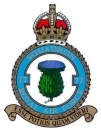






 info@77squadron.org.uk
info@77squadron.org.uk








